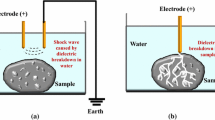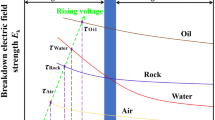Abstract
The high-voltage pulse technique is considered as a promising method for rock fragmentation in rock engineering. Understanding the fracture modes and fragment distribution of rocks subjected to high-voltage pulses is thus essential. In this work, a circuit system for rock breaking by high-voltage pulses discharge was established. The fracturing effect on granite under high-voltage pulses was explored and changes in the median size of fragments with specimen size, charge voltage, and energy density were investigated. The results showed that a breakdown, radial crack, and circumferential crack zone are formed within granite specimens. With the growth of specimen sizes, the average breakdown voltage of granite shows only a marginal change, and the median size of fragments gradually increases. As the charge voltage increases, the median size of fragments is reduced. Additionally, the median size of the fragments attenuates exponentially with the energy density. Furthermore, microscopic analysis using a scanning electron microscope indicated that high-temperature melting and shock waves are the dominant factors in inducing rock fracturing.
Article highlights
-
A circuit system for rock breaking under high-voltage pulses is developed.
-
The fracture modes and fragment distribution of granite under high-voltage pulses are analysed.
-
The microscopic characteristics of granite fragments under high-voltage pulses are analysed.















Similar content being viewed by others
References
Andres U, Timoshkin I, Jirestig J, Stallknecht H (2001) Liberation of valuable inclusions in ores and slags by electrical pulses. Powder Technol 114:40–50
Banadaki MMD, Mohanty B (2012) Numerical simulation of stress wave induced fractures in rock. Int J Impact Eng 40:16–25
Bakhtavar E, Hosseini S, Hewage K, Sadiq R (2021) Green blasting policy: simultaneous forecast of vertical and horizontal distribution of dust emissions using artificial causality-weighted neural network. J Clean Prod 283:124562
Cho SH, Cheong SS, Yokota M, Kaneko K (2016) The dynamic fracture process in rocks under high-voltage pulse fragmentation. Rock Mech Rock Eng 49:3841–3853
Dong LJ, Tong XJ, Li XB, Zhou J, Wang SF, Liu B (2019) Some developments and new insights of environmental problems and deep mining strategy for cleaner production in mines. J Clean Prod 210:1562–1578
Entacher M, Lorenz S, Galler R (2014) Tunnel boring machine performance prediction with scaled rock cutting tests. Int J Rock Mech Min Sci 70:450–459
Hassani F, Nekoovaght PM, Gharib N (2016) The influence of microwave irradiation on rocks for microwave-assisted underground excavation. J Rock Mech Geotech Eng 8(1):1–15
Ito M, Owada S, Nishimura T, Ota T (2009) Experimental study of coal liberation: electrical disintegration versus roll-crusher comminution. Int J Miner Process 92:7–14
Kahraman S, Canpolat AN, Fener M, Kilic CO (2020) The assessment of the factors affecting the microwave heating of magmatic rocks. Geomech Geophys Geo-energ Geo-resour 6(4):1–16
Li XB, Wang SF, Wang SY (2018) Experimental investigation of the influence of confining stress on hard rock fragmentation using a conical pick. Rock Mech Rock Eng 51(1):255–277
Li YS, Liu J, Feng BY, Zhang XR, Zhang MY, Xiao HL, He MB, Shi FN (2021) Numerical modeling and simulation of the electric breakdown of rocks immersed in water using high voltage pulses. Geomech Geophys Geo-energ Geo-resour 7(1):1–21
Ouchterlony F, Sanchidrián JA (2019) A review of development of better prediction equations for blast fragmentation. J Rock Mech Geotech Eng 11(5):1094–1109
Pan C, Li X, Li JC, Zhao J (2021) Numerical investigation of blast-induced fractures in granite: insights from a hybrid LS-DYNA and UDEC grain-based discrete element method. Geomech Geophys Geo-energ Geo-resour 7(2):1–18
Rostami J (2016) Performance prediction of hard rock tunnel boring machines (TBMs) in difficult ground. Tunn Undergr Sp Tech 57(6):173–182
Rezaeineshat A, Monjezi M, Mehrdanesh A, Khandelwal M (2020) Optimization of blasting design in open pit limestone mines with the aim of reducing ground vibration using robust techniques. Geomech Geophys Geo-energ Geo-resour 6:1–14
Shi XM, Duan YL, Han B, Zhao J (2020) Enhanced rock breakage by pulsed laser induced cavitation bubbles: preliminary experimental observations and conclusions. Geomech Geophys Geo-energ Geo-resour 6(1):1–12
Vogler D, Walsh SDC, Saar MO (2020) A numerical investigation into key factors controlling hard rock excavation via electropulse stimulation. J Rock Mech Geotech Eng 12(4):793–801
Walsh SDC, Vogler D (2020) Simulating electropulse fracture of granitic rock. Int J Rock Mech Min Sci 128:104238
Yang HS, Rai P (2011) Characterization of fragment size vis-à-vis delay timing in quarry blasts. Powder Technol 211:120–126
Yang LY, Ding CX, Yang RS, Lei Z, Wang J (2018) Full field strain analysis of blasting under high stress condition based on digital image correlation method. Shock Vib 2018:1–7
Yan FZ, Xu J, Lin BQ, Peng SJ, Zou QL, Zhang XL (2019) Changes in pore structure and permeability of anthracite coal before and after high-voltage electrical pulses treatment. Powder Technol 343:560–567
Yudin AS, Zhurkov MY, Martemyanov SM, Datskevich SY, Vazhov VF (2019) Electrical discharge drilling of granite with positive and negative polarity of voltage pulses. Int J Rock Mech Min Sci 123:104058
Yaghoobi H, Mansouri H, Farsangi MAE, Nezamabadi-Pour H (2019) Determining the fragmented rock size distribution using textural feature extraction of images. Powder Technol 342:630–641
Yan FZ, Xu J, Peng SJ, Zou QL, Li QG, Long K, Zhao ZG (2020) Effect of capacitance on physicochemical evolution characteristics of bituminous coal treated by high-voltage electric pulses. Powder Technol 367:47–55
Yu HW, Li YH, Cui GL, Elsworth D, Liu JP, Liu MF (2021) A model for focused-beam microwave heating on rock fracturing. Geomech Geophys Geo-energ Geo-resour 7(2):1–22
Zhu ZM, Mohanty B, Xie HP (2007) Numerical investigation of blasting-induced crack initiation and propagation in rocks. Int J Rock Mech Min Sci 44(3):412–424
Zhang YN, Deng JR, Deng HW, Ke B (2019) Peridynamics simulation of rock fracturing under liquid carbon dioxide blasting. Int J Damage Mech 28(7):1038–1052
Zhang XL, Lin BQ, Li YJ, Zhu CJ (2020) Experimental study on the effect of coal thickness and breakdown voltage on energy conversion during electrical disintegration. Fuel 259:116135
Zhu XH, Luo YX, Liu WJ (2020) On the rock-breaking mechanism of plasma channel drilling technology. J Petrol Sci Eng 194:107356
Acknowledgements
This work was supported by the Fundamental Research Funds for the Central Universities (N2101030).
Author information
Authors and Affiliations
Corresponding author
Ethics declarations
Conflict of interest
On behalf of all authors, the corresponding author states that there is no conflict of interest.
Additional information
Publisher’s Note
Springer Nature remains neutral with regard to jurisdictional claims in published maps and institutional affiliations.
Rights and permissions
Springer Nature or its licensor (e.g. a society or other partner) holds exclusive rights to this article under a publishing agreement with the author(s) or other rightsholder(s); author self-archiving of the accepted manuscript version of this article is solely governed by the terms of such publishing agreement and applicable law.
About this article
Cite this article
Peng, J., Du, C., Zhang, F. et al. Fracture and fragmentation of granite specimen under high-voltage pulses. Geomech. Geophys. Geo-energ. Geo-resour. 8, 200 (2022). https://doi.org/10.1007/s40948-022-00507-x
Received:
Accepted:
Published:
DOI: https://doi.org/10.1007/s40948-022-00507-x




